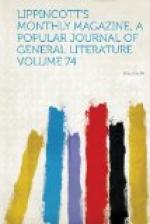After another winter in Goettingen he set out for Paris, which city he reached early in April, 1817. One of the first things he did was to go to the theatre, where he saw Talma and Mademoiselle Mars play together. But stronger tastes drew him more frequently into the best society that capital afforded him. One of the persons he was most anxious to meet was Madame de Stael, but although he presented his letters, her illness prevented her seeing him for some time, and her daughter, the Duchesse de Broglie, received him in her mother’s stead. It was there that he met Humboldt, of whom he has recorded that he “sleeps only when he is weary and has leisure, and if he wakes at midnight he rises and begins his work as he would in the morning. He eats when he is hungry, and if he is invited to dine at six o’clock, this does not prevent him from going at five to a restaurant, because he considers a great dinner only as a party of pleasure and amusement. But all the rest of the time, when he is not in society, he locks his door and gives himself up to study, rarely receiving visits but those which have been announced the day previous, and never, I believe, refusing these.” These habits are not commonly supposed to promote longevity. Before he left Paris Madame de Stael was able to see him, and with her he had an interesting conversation in which she said of America, “Vous etes l’avant garde du genre humain, vous etes l’avenir du monde,” and made two or three brilliant speeches, at which he noticed her glow of animation. At the same place he also met Chateaubriand and Madame Recamier, between whom he sat at dinner. The romantic reader will be disappointed with his meagre statements here, which hardly bring these two people more distinctly before us than are Solomon and the queen of Sheba. We read that Madame Recamier’s figure was fine, her mild eyes full of expression, and her arm and hand beautiful, her complexion fair, her expression cheerful and her conversation vivacious; of Chateaubriand, that he was a short man with a dark complexion, black hair and eyes, and a marked countenance; but exacter details of their characteristics or mutual relations are wholly wanting. While it is to be remembered that we who read Mr. Ticknor’s diary and letters have also read a great many other letters that have given us much more knowledge about Madame Recamier than her companion at that dinner could have had, it is yet fair to say that in general the book contains no traces of acute observation or quick social sensibility, but is rather marked by the faithfulness of his report of the more obvious incidents that occurred when he met these interesting people. This does not diminish the value of the book: it should only prepare the reader to find the anecdotes constituting the really important part of it, with but little sign of any study of character, and of little sympathetic insight into the feelings of others.




